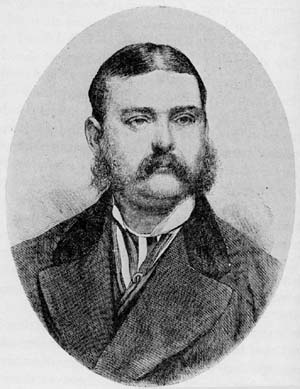
| Home | Information | Contents | Search | Links |
 |
(Samuel) Bracebridge Hemyng, popular English dime-novelist, or, as he would be called over there, writer of "bloods," was born in London in 1841, the eldest son of Dempster Hemyng of the English bar. Bracebridge was educated at Eton, then, following his father's footsteps, he entered the Middle Temple and was called to the bar in 1862. As a barrister, however, he was not a success. He had begun writing two years before, and contributed "The Curate of Invinsk" to the Morning Star. This being moderately successful, induced him to continue writing, and he soon turned out novels at a great rate, so that in the next twenty-five years he had some fifty to his credit. He began to write for Edwin J. Brett in London in 1868, and on July 23, 1871, the first of his "Jack Harkaway" stories appeared in the weekly Boys of England. It was reprinted in Frank Leslie's Boys' and Girls' Weekly in December of the same year. In 1873 Leslie engaged Hemyng to write exclusively for his papers,(1) and paid him $10,000 a year. Hemyng, consequently, came to America and remained with Leslie for a number of years. In 1874 "Jack Harkaway in America" began in No. 379 of this paper. After some years Hemyng fell out with his publishers and returned to England, but in 1878, before leaving America, he had written two stories for the Police Gazette, "Left Her Home; or, The Trials and Temptations of a Poor Girl," and "Steps to Ruin; or, Gaslight Temptations."
It has been said that "Jack Harkaway in New York" was not written by Hemyng, although it is signed with his name. However, it first appeared in Beadle's Young New Yorker, and an announcement in that weekly said, April 12, 1879, that the story was "written expressly for us by Mr. Hemyng." Hemyng was still in America at that time, so it is very unlikely that this statement would have been made had it been untrue. The story was reprinted July, 1879, in No. 101, Half-Dime Library.
When Hemyng was in America he lived in grand style on Staten Island. It is said(2) that he had a mad wife, who would throw stones, books, dishes, or any other object that was handy at Hemyng and his guests. She died later, after having been found wandering half naked through the woods. In the 1880's, in London, he married again and returned to the practice of law although he continued to write novels to some extent and published in such papers as Good New, Half Holiday, etc., in 1897-98. During his absence in America, however, other writers had arisen, and Hemyng's stories were not so popular as they once had been. He died in London, September 18, 1901, practically penniless.
REFERENCES; Frank Leslie's Boys of America, II, 1874, 80, 117, with a portrait and an illustration showing Hemyng greeted on his arrival in America by the boys of New York; Frank Leslie's Boys' and Girls' Weekly, No. 391, 1874; XXIX, September 17, 1880, 94; XXX, April 16, 1881, 158; XXX, February 26, 1881, 46 (the last three items in the Correspondents' Column); The Jouralist, August 7, 1886; Publishers' Weekly, LX, November 16, 1901, 1045; The People, September 22, 1901; Literary Year Book, 1902, 69; Dime Novel Round Up, VI, 1937, No. 67; VII, 1938, Nos. 76, 78; X, 1942, No. 115; Bookseller (London), October 11, 1901, 777.
Saturday Journal. No. 464
Banner Weekly. No. 737
Young New Yorker. Nos. 13, 23 (incomplete)
Half-Dime Library. Nos. 89, 91, 101 (complete), 1062,
1069
Pocket Library. Nos. 75, 86, 121
† Correction made as per Volume 3.
Notes
| 1 | Frank Leslie's Boys' and Girls' Weekly, No. 377, contains a letter from Hemyng confirming this statement. |
| 2 | The Newsman, †III, September, 1886, 157. |